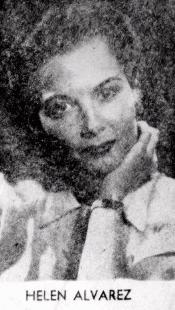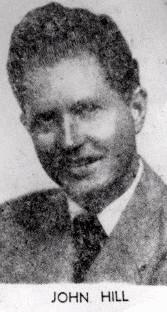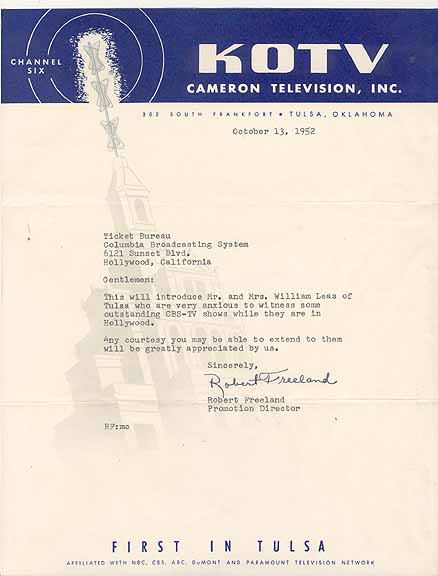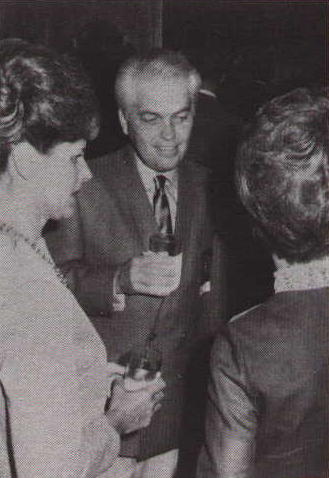CHAPTER 2 KOTV
"Something for everyone" was the way Tulsa's first television station was described by its first manager, Maria Helen Alvarez.1 There was no question but that Miss Alvarez was solely responsible for the emergence of television in northeastern Oklahoma. Something for everyone indeed. Through an astute bargaining ability, Miss Alvarez had secured agreements with five television networks and corporations to supply her with program material. Until early in 1954, Tulsans were afforded the most complete programming that-could be supplied to a one-station market.2 The grand and glorious sight of a television test pattern did not come easy to Helen Alvarez. She worked for it. As early as 1944, Miss Alvarez had expressed an interest in television. On a business trip to Washington, she visited the DuMont Television Studios and witnessed her first television show. From that moment television became her entire life.
Another year was too long to wait as far as Miss Alvarez was concerned. She resigned her position at KTUL and cast about in search of the party, or parties, who wanted to act immediately. In her quest, she found any number of persons who were interested, but unfortunately, had little or no capital to finance the venture. One night at a party, she met a man who was not only interested in the project, but who also received a monthly royalty check for $50,000. George Cameron held extensive oil properties in the Mid-Continent and Rocky Mountain region and wished to invest his mounting capital in a new enterprise.
The Cameron Television Corporation soon received approval of its application for a Construction Permit. However, they had prepared the application in error, and one important change had to be made before further work could continue. The Commission had awarded the Construction Permit to Station KOVB Tulsa which was an obvious error in that the group had asked for the call letters KOTV. Because of the inaccessibility of the original principals at this writing, the reason for this misunderstanding cannot be clarified. A formal request to change the call letters to KOTV was filed and subsequently approved by the Commission in May of 1948.4 All that remained was to build the station, erect the transmitter, and make the station operable. To learn the intricacies involved in the building of a television facility, Miss Alvarez visited existing stations to obtain first-hand information. In all, she inspected 42 of the 89 stations already on the air in the United States. With Hill as the commercial manager and herself as president, the necessary preparations for readying the station for its debut continued. Cameron spent much of his time in California supervising his many oil properties and did not devote his time to the problems of the station.5 From May 1948 until October of 1949 Miss Alvarez continued her search for the best in personnel and equipment. Every little setback that KOTV encountered was quickly met with a chorus of "I-told-you-so" by skeptical gloomcasters. During the installation of the tower atop the National Bank of Tulsa building an incident occurred that caused the cry of "jinx" to be uttered by many detractors.6 Miss Alvarez had spent a full year in convincing the bank officials that the tower would not only be safe, but would function as a landmark for Tulsans. No sooner had work begun on the tower than a workman's wrench fell from the 1100-foot tower, striking and killing a woman shopper passing below. It seemed as if the venture was indeed "jinxed." Miss Alvarez, however, did not let this misfortune slow her down.
Key personnel were hired from New York, Hollywood, and other metropolitan areas. Before the station ever went on the air, nearly a half-million dollars was spent in preparation. In an interview with a St. Louis Post-Dispatch reporter, Miss Alvarez made the statement that the station would be operating in the "black" within six months of signing on. This utterance was taken as further proof of "Cameron's Folly" as the venture had come to be called.9 Construction continued and another full-time secretary was hired to work from 5:00 P.M. to 11:00 P.M., as the eight-to-five girl could scarcely keep up with the many letters and memos that her perpetually moving boss turned out each day.10 The summer of 1949 was quite hectic for Helen Alvarez. Several more construction accidents occured, incorrect wire was delivered to the technicians, and talks with the.various networks were exhausting.11 As late as July "experts" were quite free in their opinion that television in Tulsa was off in the future. At a Chamber of Commerce luncheon in July, a prominent Tulsa radio executive publicly stated that anyone who invested in the purchase or a television set was foolish.12 Despite the many setbacks, all was in readiness for KOTV to take to the airwaves on October 15, 1949. One month later on November 30, 1949, the monthly meeting of the Chamber of Commerce was viewed by Chamber members as well as the "foolish" Tulsans who had purchased receivers. Ironically, many of the persons who had decried the possibility of ever seeing television in Tulsa were among those seen on the television screens that afternoon at the Tulsa Club.13 On December 1, 1949, viewing and telecasting were simultaneously going on in the Tulsa area. The first scheduled programming was a two-hour sampling or the top programs from all the networks. Over 3,000 receivers were scattered throughout the city for public viewing. Some sets were even placed on sidewalks in front of appliance stores. Crowds quickly formed to see their first glimpse of the new medium. After several days of this program sampling, the public began to purchase the sets and KOTV soon had an extensive viewing audience in four states.14 Those first programs were entirely on film or kinescope, as the coaxial cable had not yet reached the southwest. A full one third of the KOTV broadcast day was devoted to live, local programs. A few "on camera" incidents combined to give officials of the station some misgivings about the merits of live programming. One such incident concerned a sporting goods sponsor who had the reputation of having the handsomest salesmen in Tulsa. It was agreed that it might be a good idea to use these photogenic men as pitchmen for the store's products on the live commercials. This procedure proved to be ideal until the night one of the men not only forgot his firm's product, but even the name of the firm.15 Lcngtime employees of the station have their own recollections or those first days of television in Tulsa. Former Publicity Director, Robert Freeland, remembers the period quite well. Freeland, who now operates his own advertising agency, received many calls from viewers in Missouri, Kansas and Arkansas on the quality or the picture received in those states. The first program schedule called for approximately three hours of programming each night. George Jacobs, the station's Chief Engineer today (as he was the day KOTV signed on in 1949) recalls that almost without exception there was a full week's delay in receiving the network telecasts. This was most noticeable when KOTV aired a memorable Christmas show on New Year's Day. The broadcast day gradually expanded as techniques were perfected and network affiliations were solidified. Both Freeland and Jacobs recall that the announcement that the station would program from noon until midnight was cause for celebration at the studio. Commercial Manager and co-owner, John Hill, did such an outstanding job in selling the station to prospective advertisers that the station was operating in the black within four months of signing on. His first sale was to the Oklahoma Natural Gas Company. In fact, ONG holds a record in the entire television industry as having the longest continuous advertising schedule of any American sponsor.16 Their popular cooking show runs today in the same manner as it did years ago.17 Under Miss Alvarez the station literally flourished. Network relations were quite smooth, although the station preferred CBS to the others. For her part, Miss Alvarez preferred the late-night "Broadway Open House" to any other show her station programmed. This was partly because she was an incurable insomniac who seldom retired early.17 When Miss Alvarez was seeking ideas, she happened to visit San Diego station KFMB. She followed closely the workings of the west coast television station in planning her facilities and programming.18 Provisions were made to accommodate a studio audience of 400 people. Freeland recalls that many of the early live programs were attended by large audiences.
In 1952 KOTV gained a power increase, but lost several of its top personnel to the networks. Through the years KOTV has sent many graduates from Tulsa to broadcasting centers across the nation. Singer Anita Bryant made her debut on Channel Six as did Louise O'Brien, who transferred her popular afternoon woman's show to CBS in New York. The News Department of KOTV has lost the services of Jim Ruddle and Harry Volkman to Chicago audiences. Two other alums of Tulsa television now in network capacities are Roger Sharp with ABC in New York, and Jim Hartz, who has a nightly newscast on NBC in New York City.21 By the summer of 1952 there were two micro-wave relay systems nearing completion. Tulsa was scheduled to hook-up with the northern system through Kansas City, which would bring programs originating on the east coast to Tulsa. No provision was made at that time for west coast programs to be.aired "live" beyond their immediate western area.22 When it was learned that the northern relay system would not be completed in time for the National Conventions of 1952, many viewers made public their disappointment.23 KOTV officials immediately made arrangements to hook-up with the southern relay system through Dallas in order to carry the political conventions live and not a week later. Robert Freeland, for one, feels that this single factor sold more television receivers than any other in the period 1949-1954. Few events were ballyhooed as much as the National Conventions of 1952. George Jacobs recalls that the advent of the relay system marked an end to the days of delayed programming. Jacobs completed the necessary wiring by July 1, a full week ahead of the opening of`the Republican National Convention in Chicago. At the peak of this heightened interest in television, the station changed hands. A Texas oilman, Jack D. Wrather, Jr., and his mother, Mazie Wrather, wished to enter into the television business. Wrather, who was married to actress Bonita Granville, approached the owners of KOTV, George Cameron, Helen Alvarez, and John Hill about the possibility of purchasing the station. Cameron, who had far flung oil interests to manage, was amenable to a sale, as was John Hill, who was anxious to get into real estate. The Wrathers knew nothing about the management of a station and therefore requested that Miss Alvarez continue the management of the station. Miss Alvarez was given 50 per cent of the stock in the new corporation which was subsequently named the Wrather-Alvarez Television Corporation.24 Cameron and Hill were given $2,500,000 for their stock in the successful station that cost $400,000 to build three years earlier. At the time of the sale it was agreed that John Hill would become a partner in a corporation that would include the Wrathers and Miss Alvarez. Hill, however, decided to go ahead with his plans to enter the real estate business and left the group. While the ink was still drying on the contract papers, plans were announced for a station to be built in Corpus Christi, Texas. Robert Freeland, then Assistant Station Manager, went to Corpus Christi to prepare the necessary paper work. The Commission, however, awarded the allocation to a group of Corpus Christi merchants, causing the Tulsa promoters to look elsewhere.25 Miss Alvarez, remembering the well-managed San Diego Station, convinced the Wrathers to look at it. They liked the station, and with Miss Alvarez, applied for it. The sale was approved by the Commission and KFMB became a sister station to KOTV.26 Soon after the acquisition of the west coast station, the Wrather-Alvarez organization stepped up programming in Tulsa. KOTV was soon telecasting from 6:45 A.M. until 12:30 A.M. seven days a week, The KOTV network affiliations were now reduced to four, as the Paramount Television Corporation no longer produced programs. In an expansion move ABC had acquired Paramount's television interests to combine with their own, so that the amount of programming was not affected.27 The year 1954 was most eventful for Tulsa as several additional channels became operational. KOTV continued to use programs from all four networks but agreed to share affiliates with the new entries. While advertising copy listed all networks, only CBS was listed in bold lettering.28 In April, 1954, KOTV installed colorcasting equipment and agreed to carry NBC color programs. The first such program to be telecast in color in Tulsa was the NBC presentation of "Ding Dong School" on May 21, 1954. In all, KOTV carried 22 programs in color from NBC before relinquishing that network to KVOO in December, 1954.29 Meanwhile, Jack Wrather, his mother Mazie, and Miss Alvarez, had formed the General Television Corporation but had acquired no further television properties. The Wrathers, who received a check for $33,000 from their oil properties daily, were spending an increased amount of time away from Tulsa.30 Miss Alvarez, who was quite wealthy on paper, but not in actual cash, was now eager to move to the west coast. She wanted to enter into the real estate business there as well as concentrate solely on the management of San Diego station, KFMB.31
The sale did not disrupt the operation of the station. Dick Campbell remained as manager of KOTV until C. Wrede Petersmeyer was named president of KOTV Incorporated 33 in November, 1954.33 Shortly after Petersmeyer took over, KOTV completed work on a new tower located on a mountain north of Sand Springs. The new tower replaced the one that had been erected atop the NBT building five years earlier. Petersmeyer named the site Big Heart Mountain, and KOTV was soon boasting 100,000 watts of power.34 KOTV donated antenna space on the new tower to ETV station KOED. At that time the 1135 foot tower was the fifth tallest structure in the world.35 The purchase of KOTV in 1954 by the Whitney Corporation marked the beginning of the Corinthian Broadcasting Corporation. Other acquisitions soon followed and, today there are five stations in the group.36 C. Wrede Petersmeyer returned to New York to head the Corinthian Organization. He left the station in the hands of James C. Richdale, Jr., former commercial manager. Assisting Richdale in Sales was George Stevens, who was named commercial manager. During Richdale's tenure, the practice of editorializing began. The first editorial was delivered by Richdale in the spring of 1956. Since that time over 900 editorials have been aired by KOTV on many diverse subjects.37 In September of 1958 Richdale was sent by Corinthian officials to manage their Houston station, KHOU. President Petersmeyer named Commercial Manager George Stevens to succeed Richdale as manager. Also in 1958 KOTV became the first television station in Oklahoma to install video tape equipment.38 James Maxwell, then Mayor of Tulsa, astonished to see a replay of his visit to the station moments after it was concluded.39 In 1959 KOTV added the necessary equipment to telecast local film shows in color.40 George Stevens remenbers that color was not in demand as much then as there simply were not many color receivers in operation. The years 1962 to 1966 saw KOTV accept the Marshall Gregory award for best editorializing four times. December, 1966 marked the beginning of local colorcasts for Tulsa's pioneer television station.
2 Interview with Odene Brinlee, former Secretary to Helen Alvarez, March 3, 1967. 3 Interview with Helen Alvarez by Peter Wyden of the St. Louis Post-Dispatch, June 22, 1952. 4 Broadcasting Magazine (Washington, D.C.: Broadcasting Publications, Inc.), May 17, 1948 5 Interview with Robert Freeland, former publicity Director of KOTV, March 24, 1967. 6 Daily Oklahoman, October 23, 1949. 7 lnterview with George Jacobs, Chief Engineer of KOTV, April 18, 1967. 8 Tulsa Sunday World, November 27, 1949. 9 St. Louis Post-Dispatch Interview, op. cit. 10 Interview with Odene Brinlee, op. cit. 11 Interview with Robert Freeland, op. cit. 12 St. Louis Post-Dispatch Interview, op. cit. 13 Tulsa World, December 1, 1949. 14 Interview with Robert Freeland, op. cit. 15 Interview with Odene Brinlee, op. cit. 16 Interview with Dale Hart, Commercial Manager of KOTV, citing television industry advertising reports, March 3, 1967 17 Interview with Odene Brinlee, op. cit. 18 Interview with Robert Freeland, op. cit. 19 Tulsa World, October 16, 1951. 20 Tulsa World, June 10, 1952. 21 Interview with Odene Brinlee, op. cit. 22 Tulsa World, Entertainment Section, June 10, 1952. 23 Tulsa Tribune, July 1, 1952. 24 Tulsa World, June 3, 1952 and June 10, 1952. 25 Interview with Robert Freeland, op. cit. 26 Broadcasting Yearbook (Washington, D. C.: Broadcasting Publications, Inc., 1952). 27 Interview with Robert Freeland, op. cit. 28 Interview with George Stevens, General Manager of KOTV, March 8, 1967. 29 Interview with Dale Hart, op. cit. 30 St. Louis Post-Dispatch Interview, op. cit. 31 Interview with Odene Brinlee, op. cit. 32 Interview with George Stevens, op. cit. 33 Tulsa World, November 10, 1954. 34 Interviews with Freeland and Hart, op. cit. 35 Tulsa Tribune, November 10, 1954. 36 Telecasting Yearbook (Washington D. C.: Broadcasting Publications, Inc., 1966). (Other television stations in the Corinthian group include: KHOU-Houseon, WANE-Fort Yayne, WISH-Indianapolis, and KXTV-Sacramento.) 37 Interview with George Stevens, op. cit. 38 Daily Oklahoman, June 7, 1959. 39 Tulsa World, June 4, 1958. 40 Tulsa Tribune, December 25, 1959.
|
 On October 15, 1949, KOTV, the ninetieth television station
in America, telecast its first test pattern. Tulsa's first television station
was "on the air." The relatively few Oklahomans owning television sets turned
their control knobs to Channel Six on that fall day and did not touch the
knob again for almost five years.
On October 15, 1949, KOTV, the ninetieth television station
in America, telecast its first test pattern. Tulsa's first television station
was "on the air." The relatively few Oklahomans owning television sets turned
their control knobs to Channel Six on that fall day and did not touch the
knob again for almost five years.
 In 1946 Miss Alvarez was assigned by officials of KTUL Radio to make a study
of television's possibilities in Tulsa. She spent every weekend visiting
various television stations already in operation throughout the United States.
She read every book concerning television and took correspondence courses
in electronic engineering. She talked with the business leaders in Tulsa
and in other northeastern Oklahoma communities. At the end of her research,
she advised the Tulsa Broadcasting Company to apply for a Construction Permit
without delay. The reaction of the KTUL executives was a conservative, "Let's
not rush; let's wait one more year.3
In 1946 Miss Alvarez was assigned by officials of KTUL Radio to make a study
of television's possibilities in Tulsa. She spent every weekend visiting
various television stations already in operation throughout the United States.
She read every book concerning television and took correspondence courses
in electronic engineering. She talked with the business leaders in Tulsa
and in other northeastern Oklahoma communities. At the end of her research,
she advised the Tulsa Broadcasting Company to apply for a Construction Permit
without delay. The reaction of the KTUL executives was a conservative, "Let's
not rush; let's wait one more year.3
 Through Cameron Miss Alvarez
met a super-salesman, John Hill, who worked for a Tulsa wire:rope firm. The
trio immediately began to formulate plans to construct a television station
in the Oil Capitol. By this time, several other groups began to express an
interest in television in Tulsa, but the Federal Communications Comission
had received only one application for the Channel Six frequency---from George
Cameron.
Through Cameron Miss Alvarez
met a super-salesman, John Hill, who worked for a Tulsa wire:rope firm. The
trio immediately began to formulate plans to construct a television station
in the Oil Capitol. By this time, several other groups began to express an
interest in television in Tulsa, but the Federal Communications Comission
had received only one application for the Channel Six frequency---from George
Cameron.


